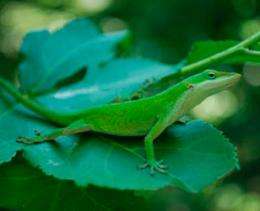The cDNA libraries of the North American green anole lizard, the first non-avian reptile to have its genome sequenced, will be housed at IU and made available to researchers around the world. Credit: David E. Scott, Savannah River Ecology Laboratory, Aiken, SC, USA
Scientists at Indiana University Bloomington's Center for Genomics and Bioinformatics are credited with constructing the cDNA libraries for the first-ever genome sequence of a non-bird reptile, the North American green anole lizard (Anolis carolinensis). The genome study appeared online earlier this month and was published today (Sept. 29) in Nature magazine.
Center genomics director John Colbourne and research scientist Zachary Smith said the center's involvement focused on providing the cDNA resources that were used to discover and characterize the transcripts -- the ribonucleic acid copies of a DNA sequence -- of green anole lizard genes as expressed under various conditions. The sequences produced by center resources helped determine the structures of Anolis genes, including alternative transcripts that produce different forms of proteins.
"This study points to the rigorous work that is necessary to achieve such outcomes," said Sarita Soni, vice provost for research at IU Bloomington. Support for the center comes in part from the Office of the Vice Provost for Research. "These scientists working in the Center for Genomics and Bioinformatics are to be commended for their excellence in basic science research and the ways in which they push the limits to make new scientific discoveries," Soni said.
A cDNA (complementary DNA) library represents cloned DNA fragments inserted into host cells that together represent a portion of an organism's transcriptome (the complete set of RNA molecule transcripts of an organism). The Anolis resource is stored at IU for distribution to the research community.
Scientists are particularly interested in the first reptile genome sequence for understanding the evolution of the amniotic egg and of vertebrate evolution more generally, as the evolution of the amniotic egg allowed vertebrates to conquer terrestrial environments. Among amniotes, genome sequences had been available for mammals and birds, but not for non-avian reptiles.
Working in a team of 50 scientists led by co-first authors Jessica Alföldi and Federica Di Palma of the Broad Institute of MIT and Harvard, Colbourne and Smith created a number of normalized cDNA libraries from a variety of Anolis tissues for sequencing in order to facilitate the annotation of genes.
"This published study of Anolis extends our involvement within the ecological and evolutionary genomics research community by helping understand the genome biology of a vertebrate that demonstrates the capacity of animals to rapidly and independently evolve shared solutions to common ecological conditions," Colbourne said.
Anoles are considered models for laboratory studies of organismal function and for field studies of ecology and evolution as they are a textbook example of adaptive radiation -- when new, related species adapt to fill ecological niches. The most famous case of adaptive radiation are the finches Charles Darwin studied in the Galapagos Islands, but the National Human Genome Research Institute chose A. carolensisis as a model reptile for genomics study because of the evolutionary value of the diversity of the genus. There are 400 species of Anoles lizards in the Caribbean and the Americas.
Some of the initial insights announced by the researchers included:
• Close to 100 conserved, non-coding elements (no longer able to copy and paste themselves) in the human genome are derived from remaining mobile elements in the lizard genome.
• By comparing proteins found in green anole and chicken eggs, researchers found egg genes in both species are evolving rapidly.
• Genes associated with the color vision green anoles rely on for mate choice were identified.
• The first analysis of anole genome microchromosomes uncovered a complete lack of isochores, regions of the genome with high or low concentrations of the nucleotides guanine and cytosine, which give human chromosomes a distinct banding pattern.
• Green anole sex chromosomes were found and appeared to have, like humans and unlike birds, XX and XY chromosomes. Male birds have two identical sex chromosomes called ZZ and females have two different ones known as ZW.
Provided by Indiana University





















